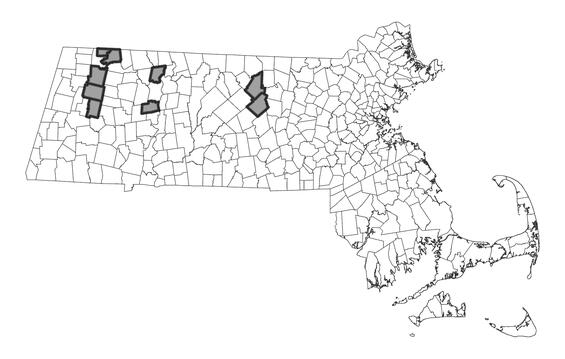- Scientific name: Juncus filiformis
- Species of Greatest Conservation Need (MA State Wildlife Action Plan)
- Endangered (MA Endangered Species Act)
Description
The thread rush (Juncus filiformis) is a grass-like, perennial herb from about an inch to fourteen inches (2-35 cm) tall. It produces loose tufts or rows of thin, round stems that appear to be without leaves. The small, brownish-green flowers of this plant are borne in loose clusters that seem to emerge from the middle portion of the straight stem. In actuality, the flowers are at the top of the true stem, and what appears to be a continuation of the stem above the flowers is a bract.
The thread rush is a “true” rush (unlike plants which share similar common names, such as bulrushes and spike-rushes) and hence belongs to the rush family (Juncaceae). Rushes in the genus Juncus are distinguished by their small brown or green flowers, which have six tepals (three sepals and three petals that all look alike). They are also characterized by having dry fruit that splits open (a capsule) along three sutures. The thread rush belongs to a group of rushes that: a) do not have leaf blades, but only leaf sheaths (the portion of the leaf that wraps around the stem), b) have flowers borne singly on a tiny stalk (rather than in clusters), and c) have inflorescences that appear lateral (appearing to emerge from the side of the stem, rather than the top, due to the terminal involucral bract mimicking a continuation of the stem).
Members of this genus are difficult to distinguish from one another, and the thread rush superficially resembles many other rushes. A technical manual should be used to identify the different species of rushes. Plants that could easily be confused with the thread rush are other rushes which appear to have lateral inflorescences. One such plant is the soft rush (Juncus effusus), which is a very common plant of wet places. The soft rush is a taller plant (40-130 cm; 15.7–51.2 in) and usually has a wider stem than the thread rush (1-2.5 mm compared to 1 mm in the thread rush). It is more strongly tufted than the thread rush and usually has more flowers in its inflorescence (greater than 20). Each flower bears three stamens in the soft rush, compared to six in the thread rush. Another plant one could confuse with the thread rush is the brackish rush (Juncus arcticus var. balticus); however, the brackish rush, as its name suggests, is a plant usually found in brackish coastal areas (the thread rush is not salt-tolerant and is not found in coastal areas of Massachusetts). In addition, the brackish rush possesses dark stripes on its tepals that are not present on those of the thread rush.
Life cycle and behavior
This is a perennial species.
Population status
The thread rush is listed under the Massachusetts Endangered Species Act as Endangered. All listed species are protected from killing, collecting, possessing, or sale and from activities that would destroy habitat and thus directly or indirectly cause mortality or disrupt critical behaviors. It is rare in this state because it is nearing the southern extent of its range. The thread rush is more common in northern New England states, and hence it is not considered to be rare throughout our region. The Massachusetts Natural Heritage & Endangered Species Program has 17 records from 3 counties: Berkshire, Franklin, and Worcester. Ten of these records have been observed within the last 25 years.
Distribution and abundance
The thread rush is primarily a northern species. In North America, it can be found from Greenland west to British Columbia and Alaska, and south to the mountains of Idaho and West Virginia.

Distribution in Massachusetts
1999-2024
Based on records in the Natural Heritage Database
Habitat
In Massachusetts, the thread rush has typically been found in wet, acidic, nutrient-poor sandy or peaty substrates along bog margins, pond shores, and in marshes. Specific habitat descriptions include the border of an acidic graminoid marsh and the margin of a sphagnous bog. The thread rush is not associated with a specific assemblage of plants in Massachusetts, but is typically found with wetland species, such as soft rush, meadow sweet (Spiraea latifolia) and steeplebush (S. tomentosa), marsh St. John's-wort (Triadenum virginicum), rhodora (Rhododendron canadense), and many species of sedges, such as the shore sedge (Carex lenticularis; threatened).
Healthy habitats are vital for supporting native wildlife and plants. Explore habitats and learn about conservation and restoration in Massachusetts.
Threats
Changes to habitat hydrology, eutrophication, and invasive species are threats to thread rush.
Conservation
As for many rare species, the exact needs for management of the thread rush are not known. The following comments are based primarily on observation of populations in Massachusetts. Since wet conditions are critical to the thread rush, an important management consideration may be to preserve site hydrology where occurrences of this species are known. Nutrient inputs surrounding stations of this species should be minimized, since this rush is adapted to compete best in acidic, nutrient-poor conditions. In addition, wet borders, marshes, and pond shores are increasingly becoming degraded by the establishment of invasive exotic plant species such as the common reed (Phragmites australis) and purple loosestrife (Lythrum salicaria). Establishment of such highly competitive species at thread rush sites could pose a serious risk to known thread rush populations, and hence upland buffers should be maintained and large-scale soil disturbances should be avoided around the wetland areas where thread rush persists. Sites should be monitored so that early detection and management can be achieved if an introduction occurs. All active management within the habitat of a rare plant population (including invasive species removal) is subject to review under MESA and should be planned in close consultation with MassWildlife’s Natural Heritage & Endangered Species Program.
Contact
| Date published: | April 25, 2025 |
|---|